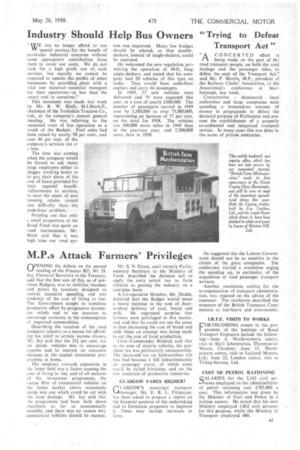E can no longer afford to rim special services for
Page 37

If you've noticed an error in this article please click here to report it so we can fix it.
the benefit of particular industrial concerns without some appropriate contribution from them to cover our costs. We do not look for a high profit out of, such services, but equally we cannot be expected to sustain the profits of other businesses by providing .them with a vital raw materiaL-4essential transport for their operative—at less than the actual cost to ourselves."
This statement was made last week by Mr. R. W. Birch, M.I.Mech.E., chairman of the.Yorkshire Traction Co., Ltd., at the company's annual general meeting. He was referring to the increased costs of bus operation as a result of the Budget. Fuel costs had been raisedby nearly. 50 per cent., and over 40 per cent. of the company's services ran at
toss,
The time was coming when the company would be forced . to . ask. many large employers either to stagger working hours or to pay their share of the cost of buses Provided for their especial benefit. Adjustments to services; to meet the needs of new . housing estates caused less difficuhy than -the. peak-hour problem.. .
Pointing out that only a small proportion of the Road Fund was spent on road maintenance, Mr. Birch said • that it was high time our road sys
" W
tern was improved. Many low bridges should be altered, so that doubledeckers, instead of single-deckers, could be operated.
He welcomed the new regulation permitting the operation of 30-ft. long single-deckers, and stated that his company had 20 vehicles of this type on order. They would have underfloor engines and carry 44 passengers.
In 1949, 57 new vehicles were delivered and 79 were expected this year, at a cost of nearly £300,000. The number of passengers carried in 1944 rose by 3,500,000 to over 75,000,000, representing an increase of 77 per cent. on the total for 1938. The vehicles ran 500,000 more miles in 1949 than in the previous year, and 2.500,000 more than in 1938.




























































































